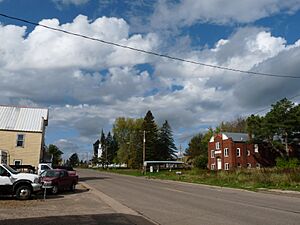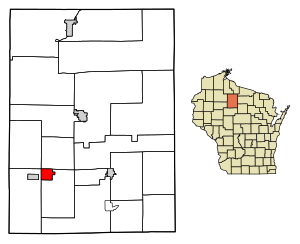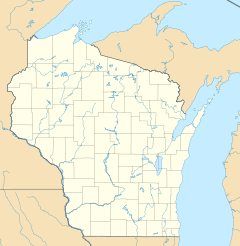Catawba, Wisconsin facts for kids
Quick facts for kids
Catawba
|
|
|---|---|

Facing west on 8, with town hall/museum on right
|
|

Location of Catawba in Price County, Wisconsin
|
|
| Country | |
| State | |
| County | Price |
| Area | |
| • Total | 4.44 sq mi (11.49 km2) |
| • Land | 4.44 sq mi (11.49 km2) |
| • Water | 0.00 sq mi (0.00 km2) |
| Population
(2010)
|
|
| • Total | 110 |
| • Estimate
(2019)
|
100 |
| • Density | 22.54/sq mi (8.70/km2) |
| Time zone | UTC-6 (Central (CST)) |
| • Summer (DST) | UTC-5 (CDT) |
| Area code(s) | 715 & 534 |
| FIPS code | 55-13175 |
Catawba is a village in Price County, Wisconsin, United States. The population was 110 at the 2010 census. The village is located within the Town of Catawba.
Contents
Geography
Catawba is located at 45°32′9″N 90°31′49″W / 45.53583°N 90.53028°W (45.535969, -90.530445).
According to the United States Census Bureau, the village has a total area of 4.46 square miles (11.55 km2), all of it land.
History
Before the railroad was built around 1884, the area that would become Catawba was a forested wilderness cut only by rivers and Indian trails. The federal government surveyed that wilderness in 1847 and 1855. In the final years before the railroad, a little pine was logged along the river and some Swedish immigrants settled near where highway 86 crosses the south fork of the Jump River.
The name Catawba is said to come from the wine - perhaps from a crew of railroad gandy dancers who overindulged on the stuff, or perhaps from local lumberjacks who partook at a saloon in Kennan.
With the railroad came more lumber camps, more settlers, and a sawmill. The first school was operating by 1892, expanded to two rooms in 1902. By 1902 Peter Hammer's Red Birch Lumber Company had a sawmill running. He and his wife Isabelle also operated the Commercial Hotel, which largely served men working in the lumber business. Hammer also operated a company store called the ACA store. Other early businesses included a lath mill, the Bendixon butcher shop, the Hamm's Brewing Company saloon and pool hall, Stevens' barber shop, Swanson's soda fountain, and Gruber's store and opera house. A Lutheran congregation was organized in 1903 - the cemetery around 1909. The Catholic church was built around 1908. The Catawba State Bank started in 1916.
The town hall was built in 1921 and the village incorporated in 1922. At some point Wisconsin Highway 14 joined the railroad passing through town. It was eventually upgraded to U.S. Route 8, and paved in 1949.
Demographics
| Historical population | |||
|---|---|---|---|
| Census | Pop. | %± | |
| 1930 | 282 | — | |
| 1940 | 290 | 2.8% | |
| 1950 | 233 | −19.7% | |
| 1960 | 230 | −1.3% | |
| 1970 | 215 | −6.5% | |
| 1980 | 205 | −4.7% | |
| 1990 | 178 | −13.2% | |
| 2000 | 149 | −16.3% | |
| 2010 | 110 | −26.2% | |
| 2019 (est.) | 100 | −9.1% | |
| U.S. Decennial Census | |||
2010 census
As of the census of 2010, there were 110 people, 60 households, and 31 families living in the village. The population density was 24.7 inhabitants per square mile (9.5/km2). There were 78 housing units at an average density of 17.5 per square mile (6.8/km2). The racial makeup of the village was 100.0% White. Hispanic or Latino people of any race were 0.9% of the population.
There were 60 households, of which 13.3% had children under the age of 18 living with them, 41.7% were married couples living together, 5.0% had a female householder with no husband present, 5.0% had a male householder with no wife present, and 48.3% were non-families. 41.7% of all households were made up of individuals, and 16.7% had someone living alone who was 65 years of age or older. The average household size was 1.83 and the average family size was 2.45.
The median age in the village was 52 years. 13.6% of residents were under the age of 18; 2.7% were between the ages of 18 and 24; 21% were from 25 to 44; 45.5% were from 45 to 64; and 17.3% were 65 years of age or older. The gender makeup of the village was 51.8% male and 48.2% female.
See also
 In Spanish: Catawba (Wisconsin) para niños
In Spanish: Catawba (Wisconsin) para niños


